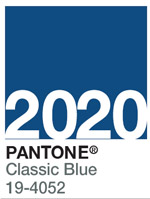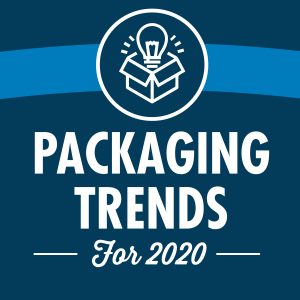A new year means new trends in packaging material and design. 2019 was a big year in packaging changes, particular with updates to the FDA’s Nutrition Labeling and Education Act (NLEA). What should you expect for 2020? We’ve summed up our top five packaging trends to be aware of as we proceed through the first year of the new decade.
Simplicity
 Packaging minimalism references not just to packaging material but also branding. Consumers are demanding straightforward, easy-to-digest designs and more and more companies are using uncluttered messaging, sophisticated colors, and bold type. This type of minimalism was unheard of years ago as brands were positioning themselves as trendy opposed to simple. With messaging and typefaces moving to the simpler side, so are colors. Pantone Color of The Year in 2019 was a bright “Living Coral” and in 2020 it moved to a familiar “Classic Blue.”
Packaging minimalism references not just to packaging material but also branding. Consumers are demanding straightforward, easy-to-digest designs and more and more companies are using uncluttered messaging, sophisticated colors, and bold type. This type of minimalism was unheard of years ago as brands were positioning themselves as trendy opposed to simple. With messaging and typefaces moving to the simpler side, so are colors. Pantone Color of The Year in 2019 was a bright “Living Coral” and in 2020 it moved to a familiar “Classic Blue.”
A company that refreshed its brand to grow with their consumer’s preference for simple and natural is Chobani. The refreshed packaging feels handmade with a sense of nostalgia, which allowed for a straightforward slogan and messaging to help consumers understand the product quickly.
Transparency
Today’s consumer is demanding more transparency than ever before. From the ingredients used to the eco-friendliness of the packaging, brands need to consider the values of today’s consumer. Much of the need for this transparency is being driven by millennials and Gen Z’ers, both of which value honesty and immediacy.
An interesting example of transparency in packaging design is RX Bar, which puts their ingredients front and center in both packaging design and marketing efforts. Brands are learning that the best way to get the attention of these digitally pre-occupied consumers is with quick, meaningful messages.
Ecommerce and Grocery Delivery
There’s no doubt that Amazon and other e-retailers have opened channels that brands could have only dreamt about a short time ago. The ability to go direct-to-consumer, throws the traditional retailer playbook out the window, but certainly comes with its challenges. One of those challenges is package design.

Ecommerce usually means that multiple hands will touch your product in pick-and-ship scenarios before being received by the customer. It also requires a different return process for damaged or unsatisfactory product. To that end, brands are redesigning their product packaging with ecommerce in mind, and many times flexible packaging is at the core of their redesign.
High amongst the advantages of flexible packaging is that it is easy to transport and store. Flexible packaging also generates less of a carbon footprint than some of its packaging alternatives, as a single truck of unfilled flexible packaging is equivalent to 26 trucks of unfilled glass jars. Finally, flexible packaging materials are easy-to-use on the go, thereby working well with products where convenience is an important purchase factor.
When we consider that grocery ecommerce is expected to nearly double by 2023, it’s not hard to imagine a change in packaging related to consumer purchase patterns.
Sustainability
According to a 2017 EPA study, 80.1 million tons of containers and packaging make up the portion of municipal solid waste and landfills received 32.1 million tons.
Many times we equate sustainability to the ease of package recycling. However, the recyclability of product packaging is only the first step in the ongoing process for brand improvement. For TerraCycle their mission is to repurpose products like batteries, backpacks, and cooking oil into something new. Loop, a new pilot program, encourages customers to buy reusable products then after use return the product package to get reused.
Packaging Innovation
In addition to the inroads in flexible packaging previously discussed, brands will continue to invest in packaging innovation ideas that save time, money and improve the overall brand experience. Two key trends that we’re paying close attention to are smart labeling and augmented reality.

A survey by the Grocery Manufacturers Association found that 70% of shoppers want more information than what is currently provided on product labels. Smart labels can detail what ingredients do and where they are sourced. Some are taking it a step further, using augmented reality to transform the brand experience. Through the use of smartphone apps, brands are able to provide an experience that extends far beyond the size limitations of the product package.




